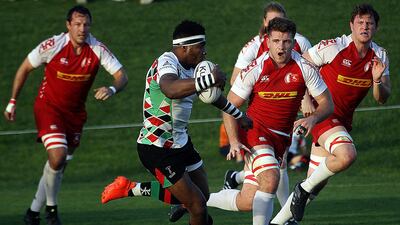Having seen a three-year unbeaten home record ended seven days earlier, Abu Dhabi Harlequins set about starting a new streak with a valuable win over Bahrain at Zayed Sports City on Friday.
Phil Brady, Luke Stevenson and Andrew Semple scored the tries as the defending West Asia Premiership champions climbed back above Jebel Ali Dragons at the top of the table.
With Dragons being without a match this weekend, Harlequins’ win was enough to edge them back into a single-point lead at the top, ahead of their conquerors from last week.
Although the final winning margin suggested a comfortable win for the home side, the run of play in the first half in particular was quite the opposite.
Brady crashed over with the first attack of the game, but they were forced to withstand 35 minutes of pressure from then until the interval.
________________________
Read more
Abu Dhabi Harlequins prop Chris Jones-Griffiths unsure about return to UAE rugby team
Noah Perelini aims to show New Zealand Schools rugby selectors 'they have to pick me'
________________________
They were not helped by their own indiscipline, as they lost two players to yellow cards. The fact they made it to the break with a 7-0 advantage in tact was due to their own doughty defence, as well as profligacy by the Bahrain attack.
Ironically, the travelling side managed their only score, a try through Rhys Fitzgerald, when they themselves were down to 14-men due to a yellow card.
Once they were back to the full quota, however, Harlequins stretched away, adding further tries via sparkling breaks by Stevenson and Semple.
“We all took it pretty badly last week, as it has been three years since we last lost at home, and it came as a bit of a shock because we didn’t really turn up,” Stevenson said.
“We knew that if we played our game we probably should have won last week. We didn’t, and they deserved it, so it was something for us to set a marker at.
“We started well today, then the yellow cards came at the worst possible time for us. We had 13 men, and we kept them scoreless for 15 minutes, which was down to good work rate.
“That is one thing we wanted to improve from last week, to make sure the work rate was higher, and keep the ball. It was pleasing to get through that first half.”
Another defeat on the road leaves Bahrain with ground to make up if they are to challenge for honours at the business end of the season.
Louie Tonkin, the Bahrain coach, said “mental issues” are holding his side back from reaching their full potential.
“I asked the boys [post match], ‘What is it?’ and I think it is down to belief, if we are honest,” Tonkin said.
“We probably had 80 per cent territory and possession in that first half, and created five try scoring opportunities, but didn’t score any of them.
“When you exert that much pressure on someone, and keep letting them off the hook, all you are doing is feeding their belief, while you are losing belief.”


